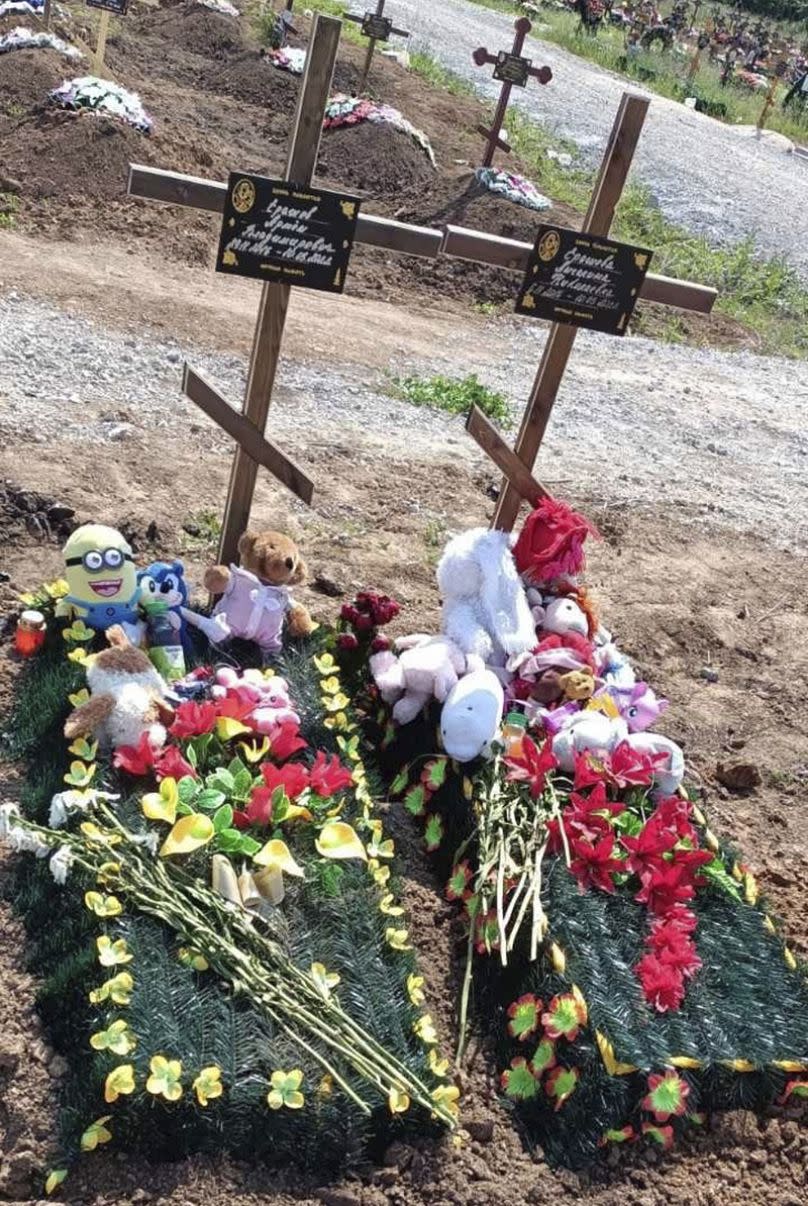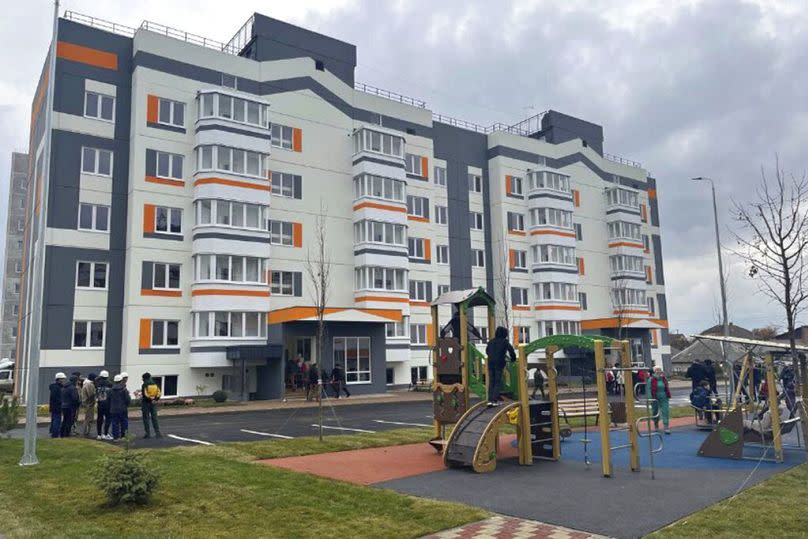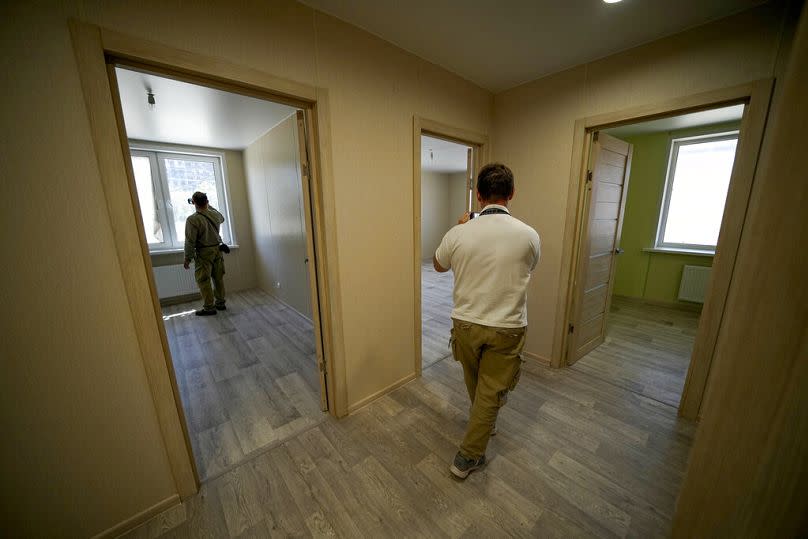In occupied Mariupol, Russia's rebuild is erasing Ukrainian identity and any evidence of war crimes

The siege, the destruction and the eventual fall of the key southern port of Mariupol have been one of the most horrific stories of Russia's war in Ukraine.
Moscow is now trying hard to rebuild the city it devastated, erasing any evidence of war crimes along the way.
Throughout the city, Russian workers are tearing down bombed-out buildings at a rate of at least one a day, hauling away shattered bodies with the debris.
Russian military convoys are rumbling down the broad avenues of what is swiftly becoming a garrison city, and Russian soldiers, builders, administrators and doctors are replacing the thousands of Ukrainians who have died or left.
Many of the city's Ukrainian street names are reverting to Soviet ones, with the Avenue of Peace that cuts through Mariupol to be labelled Lenin Avenue.
Even the large sign that announces the name of the city at its entrance has been repainted with the red, white and blue of the Russian flag and the Russian spelling.

The few open schools teach a Russian curriculum, phone and television networks are Russian, the Ukrainian currency is dying out, and Mariupol is now in the Moscow time zone.
On the ruins of the old Mariupol, a new Russian city is rising, with materials from at least one European company, The Associated Press found.
But life in occupied Mariupol also underlines what its residents already know all too well: no matter what the Russians do, they are building upon a city of death.
A blue casket for their baby boy, a pink one for his cousin
More than 10,000 new graves now scar Mariupol, the AP found, and the death toll might run three times higher than an early estimate of at least 25,000. The former Ukrainian city has also been hollowed out, with Moscow's plans to demolish well over 50,000 homes.
Death surrounds Mariupol in the rapidly growing cemeteries on its outskirts, and its stench lingered over the city into the autumn. It haunts the memories of survivors, both in Mariupol and in exile.
Every one of the dozens of residents the AP spoke with knew someone killed during the siege of Mariupol, which began with the 24 February full-scale invasion.
War in Ukraine: New satellite images show destruction of Russian-occupied Mariupol
Ukrainian soldiers including Mariupol defenders returned in prisoner swap
As many as 30 people arrive at the morgue each day in hopes of tracking down a loved one.
Lydya Erashova watched her five-year-old son Artem and her seven-year-old niece Angelina die after a Russian shelling in March. The family hastily buried the young cousins in a makeshift grave in a yard and fled Mariupol.
They returned in July to rebury the children, only to learn while on the road that the bodies had already been dug up and taken to a warehouse. As they approached the city centre, each block was bleaker than the last.

"It is horror. Wherever you look, whichever way you look," said Erashova. "Everything is black, is destroyed."
Neither she nor her sister-in-law could bear to go inside the warehouse to identify the bodies of their children.
Their husbands, who are brothers, chose the tiny coffins – one pink and one blue – to be placed together in a single grave.
Erashova, who is now in Canada, said no Russian rebuilding plan could possibly bring back what Mariupol lost.
"Our lives have been taken from us. Our child was taken from us," she said. "It's so ridiculous and stupid. How do you restore a dead city where people were killed at every turn?"
Erasing the memory of a city, one excavator at a time
All of this is a part of a comprehensive effort to suppress Mariupol's collective history and memory as a Ukrainian city, according to AP.
Mariupol was in the crosshairs of the Kremlin from the first day of the invasion. Just 40 kilometres from the Russian border, the city is a port on the Sea of Azov and it is crucial for Russian supply lines.
The city was hit relentlessly with airstrikes and artillery, its communications severed, and its food and water were cut off.
'I focused on survival': Mariupol escapee tells her story of one month in besieged city
'I was praying we would die quickly', Mariupol survivor says
Yet Mariupol refused to give in for 86 days. By the time the last Ukrainian fighters holed up in the Azovstal steel mill surrendered in May, Mariupol had become a symbol of Ukrainian resistance.
That resistance came at a high price. The thoroughness of Russia's destruction of Mariupol can still be seen today. Videos taken across the city and satellite images show that munitions have left their mark on nearly every building across its 166 square kilometres.
Large swaths of the city are devoid of colour and life, with fire-blackened walls, grey demolition dust and dead trees with shredded foliage.

But the worst destruction Mariupol suffered may be measured in its death toll, which will never be fully known.
An AP analysis of satellite imagery taken over the past eight months of occupation shows 8,500 new graves in the outlying Staryi Krym cemetery alone, with possibly multiple bodies beneath each mound.
There are at least three other trench gravesites around the city, including one created by Ukrainians themselves at the beginning of the siege.
In all, a total of at least 10,300 new graves are scattered around Mariupol, confirmed by three forensic pathologists with expertise in mass graves. Thousands more bodies likely never even made it to the graveyard.
Back in May, when the city finally fell, the municipal government in exile estimated 25,000 people at a minimum had died.
But at least three people in the city since June say the number killed is triple that or more, based on conversations with workers documenting body collection from the streets for the Russian occupation authorities.
Mariupol escapees 'have to pass through Russian filtration camps'
Ukraine war: Mariupol siege survivor says country is 'unbreakable' amid Russian invasion
Svitlana Chebotareva, a Mariupol resident who fled in March, said her neighbour died in a flat nearby, and the body is still there.
Chebotareva returned home this autumn for just long enough to retrieve her belongings since residents are free to come and go so long as they pass checkpoints. She said the Russians expect gratitude for their offer of a few new apartments.
"I don't know how it's possible now to give us 'candies' in exchange for destroyed homes and killed people," she said in Kyiv. "And they still believe it anyway."
Dear residents, we are here to demolish your homes
The notices are taped to peeling, pockmarked walls by the entry and addressed to "Dear residents".
This is how those who remained in Mariupol learn their buildings are scheduled for imminent demolition.
Often, despite shattered windows, frozen pipes and no electricity, they are still living inside because they have nowhere else to go.
More than 300 buildings in Mariupol have been or are about to be demolished. Some are individual homes, but most are multistorey apartment blocks in the so-called khrushchyovka style, launched by Soviet leader Nikita Khrushchev in a housing crisis in the 1960s.
With around 180 apartments inside or more, each building was designed to house as many families as possible.
This means that, in all, the demolitions will remove well over 50,000 homes.
"There is no discussion, people aren't prepared," said an activist in Mariupol, who, like all inside the port city, requested anonymity for fear of retribution. "People still live in the basements. Where they can go is unclear."

Only Russians handle the debris itself, according to another resident still in the city who works on the sites. The stated reason is to avoid accidents, he said.
But Petro Andryushchenko, an aide to Mariupol's mayor who is exiled in Dnipro, believes the real reason is to ensure that people do not see the rotting corpses being hauled away.
He said many of the buildings, especially in the neighbourhood around Azovstal, contain 50 to 100 bodies each that will never get a decent burial. Those deaths will go unrecorded.
One of the buildings on Russia's demolition list, scheduled to come down any day, is 110 Mytropolytska.
The smell of fresh-baked bread still brings Inna Nepomnyshaya, a doctor, back to her last night in March in her sixth-floor apartment there. When she saw the street price of bread in her besieged city, she decided to bake her own.
The smell warmed the air the next morning when her son-in-law arrived. It was time to leave, he insisted. Russian forces were closing in.
Nepomnyshaya was at her daughter's building when Russian tanks rolled up to her own at dusk on 11 March. One tank raised its gun at 110 Mytropolytska and fired.
Russia planning victory parade in Mariupol, says Ukrainian intelligence
Ukraine fears repeat of Mariupol horrors as Donbas offensive intensifies
The shell shattered the walls of Nepomnyshaya's apartment and obliterated those of the neighbours above, below and behind her.
Most of the neighbours were huddled in the basement, but two elderly women, Lydya and Nataliya, couldn't make the trip up and down the stairs.
Their bodies would be buried in the courtyard soon after.
With communications to the city cut, Nepomnyshaya did not learn of the fate of her apartment until her family had escaped to Ukrainian-held territory. Like many who left Mariupol, she still speaks of the city in the present tense.
"I live in Mariupol, this is my home," she said, speaking by candlelight in a café in Dnipro, another city that had lost power. "This house was my fortress, and they took it away from me."
Also on the demolition list are the buildings on either side. One was hit by at least one airstrike on 11 March; the walls of another are in ruins.

Russia is now moving into the historic city centre.
Russian authorities in October dismantled Mariupol's memorial to victims of the Holodomor, the Soviet-engineered famine in the 1930s that killed millions of Ukrainians, according to a video posted on Russian television.
They also painted over two murals commemorating victims of Russia's 2014 attack on Ukraine.
"They spend an inordinate amount of time focusing on things like erasing demonstrations of Ukrainian identity and very little time tending to the needs of the Mariupol people," said Michael Carpenter, US ambassador to the OSCE, which for years monitored eastern Ukraine.
"It's really a very brutal inhuman colonial experiment unfolding before our eyes."
The Potemkin theatre and Azovstal as an industrial park
As it tries to raze the remains of Ukraine, Russia has laid out a plan for a new city with a new population.
At its heart will lie the historic Mariupol theatre, according to the master plan first reported by the Russian site The Village in August.
The majestic Drama Theatre became the city's main bomb shelter until twin Russian airstrikes hit on March 16. Hundreds died, and residents said the site reeked of bodies all summer.
Mariupol theatre death toll feared to be double initial estimate
President Zelenskyy: 'My heart breaks' after Mariupol theatre bombing
To mask the ruins, Russian authorities have put up a screen so tall it can be seen from space, etching the theatre's outline on the panelling in a ghostly reminder of its previous life.
Also in the document are plans to restore the ruins of the obliterated Azovstal steel mill, the last Ukrainian holdout.
The site is slated to be transformed into an industrial park by the end of next year, though there are no signs that any work has begun.

But a Russian military compound went up in record time, according to satellite imagery from Maxar Technologies that showed the vast U-shaped building with the Russian Army slogan emblazoned on the rooftop.
Russia already has constructed at least 14 new apartment buildings — a small fraction of the number coming down — and is repairing at least two of the hospitals it damaged by shelling.
Video obtained by AP showed rows of pallets stacked with insulation from the Danish company Rockwool, which maintains its division in Russia despite criticism. Construction materials are not subject to sanctions.
In a statement, Rockwool's Vice President of Communications Michael Zarin said the insulation panels were distributed without the company's "knowledge or consent," and that he hopes its products help restore health care, warmth and shelter to Ukrainians.
Russians forces are 'inhumane' and use torture, famous Mariupol survivor says
Ukraine war: What happened to the Mariupol defenders taken captive by Russia a month ago?
Videos show no furniture visible in the windows of the new apartments and few people on the sidewalks outside.
Only pensioners, the disabled and those affiliated with the occupation seem to be getting them, according to multiple people still in Mariupol.
One man applied to the list in September and found himself in 11,700th place. He has friends in the 2,000 range who are still waiting, like him.
And an old man he knows, whose number was in the 9,000s has already moved into one of the new buildings.
"I don't know how it happens. I won't speculate," he said.

However, the man said he has no issue with the demolition of buildings that are not fit to live in. He is cautiously relaunching his own company in the new city.
But the plans for a Russian Mariupol depend on a population that simply no longer exists.
Thousands of Mariupol's former residents were sent to Russia with little or no choice, and thousands more fled to other areas of Ukraine.
Of Mariupol's former population of around 425,000, just over a quarter stayed, according to estimates from Andryushchenko.
Ukraine war: Misleading document claims majority of Mariupol population is pro-Russia
'There is no water and food': Mariupol mayor describes desperate situation
The Russian master plan for Mariupol calls for a population of 212,000 in 2022 and back to 425,000 by 2030.
Right now, about 15,000 of the people in Mariupol people are Russian troops, said Andryushchenko, who drew his estimate from information about the soldiers taking over homes and public buildings.
He said Russian riot police have begun patrolling the city to head off protests over the lack of heat, electricity and water.
Videos from the scene showed military convoys, along with construction trucks, clogging the streets. The activist the AP spoke with also confirmed an increase in the number of soldiers since Russian forces retreated from the Kharkiv and Kherson regions.
Construction workers from Russia showed no signs of leaving, and tents were visible outside the Port City mall until the winter.

Doctors and city administrators also have come in from Russia, according to Russian government announcements and physicians who left the city after refusing to work for the occupation authorities.
"There is no more Russian city now than Mariupol," Dmitry Sablin, a Russian lawmaker born in Mariupol, said in an interview with Russian media in June after visiting the city.
The Kremlin is moving as swiftly as it can to ensure that those Ukrainians who stay see their future as Russians.
On 15 November, Russian President Vladimir Putin awarded Mariupol the title of "City of Military Glory" for the heroism of people he described as its defenders.
On 7 December, Putin said his war against Ukraine had turned the Sea of Azov into "Russia's internal sea."
This suits many of those who remained behind just fine. Mariupol has always had some residents who consider themselves Russian.
"Whoever doesn't like it, doesn't come back," one woman said.
Ï for Vendetta
Russia's occupation of Mariupol has divided families and friends into two categories: those who stayed and those who fled. Both grapple with what Mariupol once was and will be.
When Ivan Kalinin escaped, he left behind the body of his wife Iryna and their unborn first child, both killed in the 9 March Russian airstrike on the maternity hospital. His parents and hers stayed in Mariupol.
He last saw his wife that morning when her labour began, and she sent him to fetch clothes and diapers.
He learned about the airstrike at a military blockade on the way to the hospital. He and his father found her body the next day at another hospital.
"I do not even know how I survived it," he said quietly. "I was drinking every day to fall asleep."

Kalinin, who now lives in Wales, cannot imagine going home. Nor can he imagine life anywhere else.
"It is too painful for me to be there. I might return at some point — it is my hometown, after all," he said. "I fall asleep every day hoping this is a dream. And I wake up with understanding that it is a reality."
Mariupol is now torn between Russia and Ukraine. Some people who stayed are waiting for Russian citizenship just to get on with their lives.
'It's important to support a nation that suffers', say French Ukraine demonstrators
No dog left behind: Meet the Ukrainian woman who evacuated 35 dogs from Mariupol
Yet the Ukrainian letter ï, which is not found in Russian, is appearing as graffiti around the city — a small act of defiance in a place many described as full of fear.
Nepomnyshaya, whose apartment was struck by a Russian shell, dreamed recently that she'd returned home and smelled bread. But she is not sure if she ever can or will go back.
"I believe that Mariupol will be rebuilt, that it will be Ukraine after all," she said. "But I know that this smell is just a memory."


